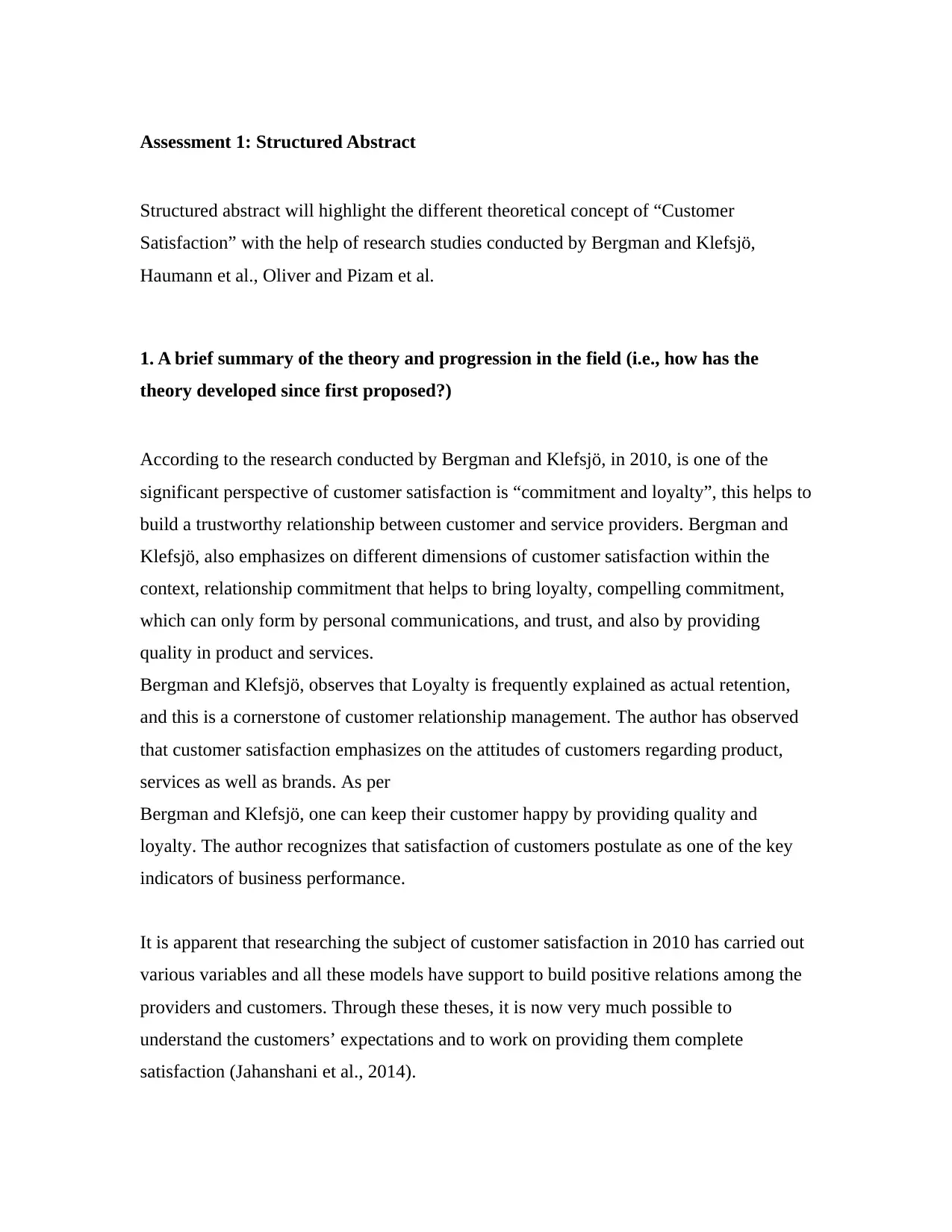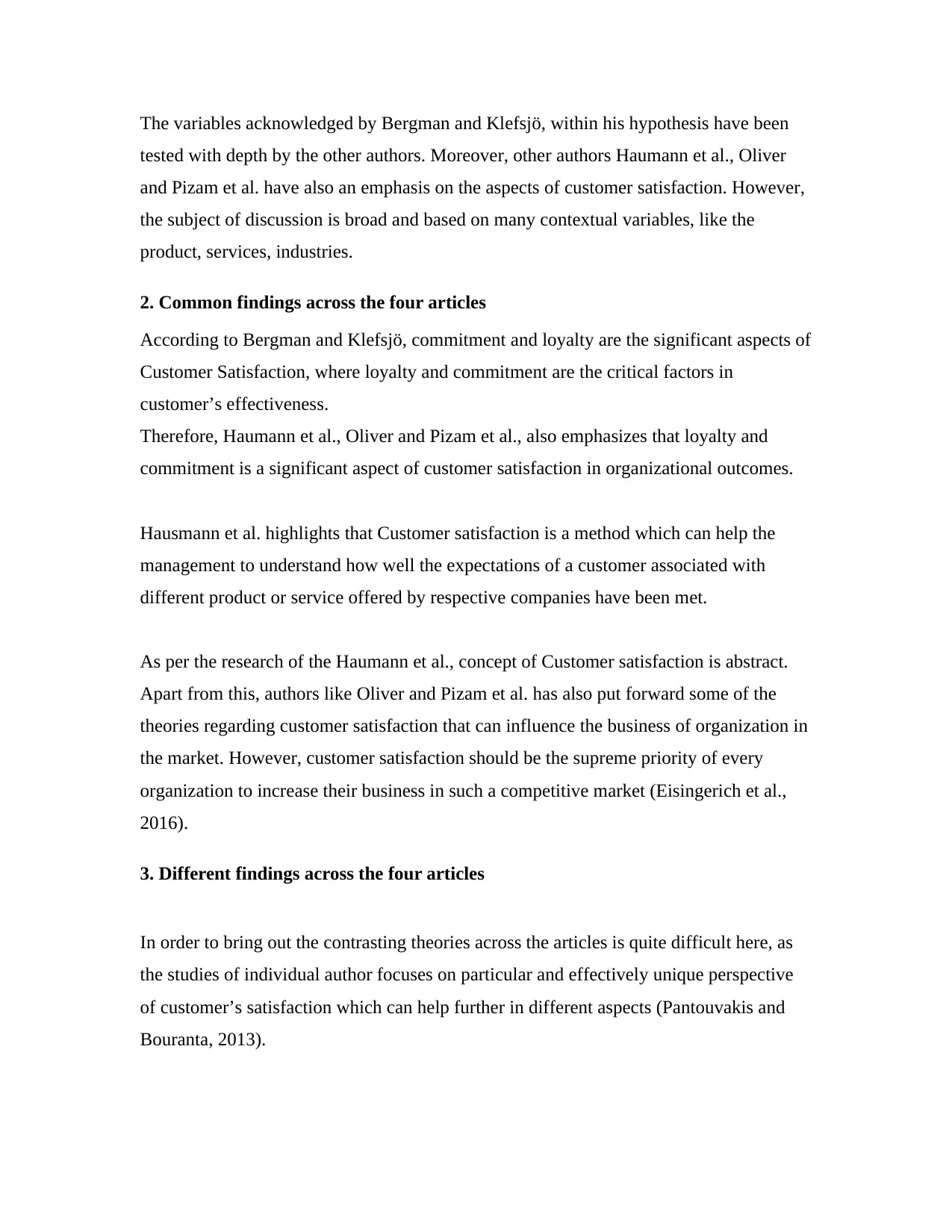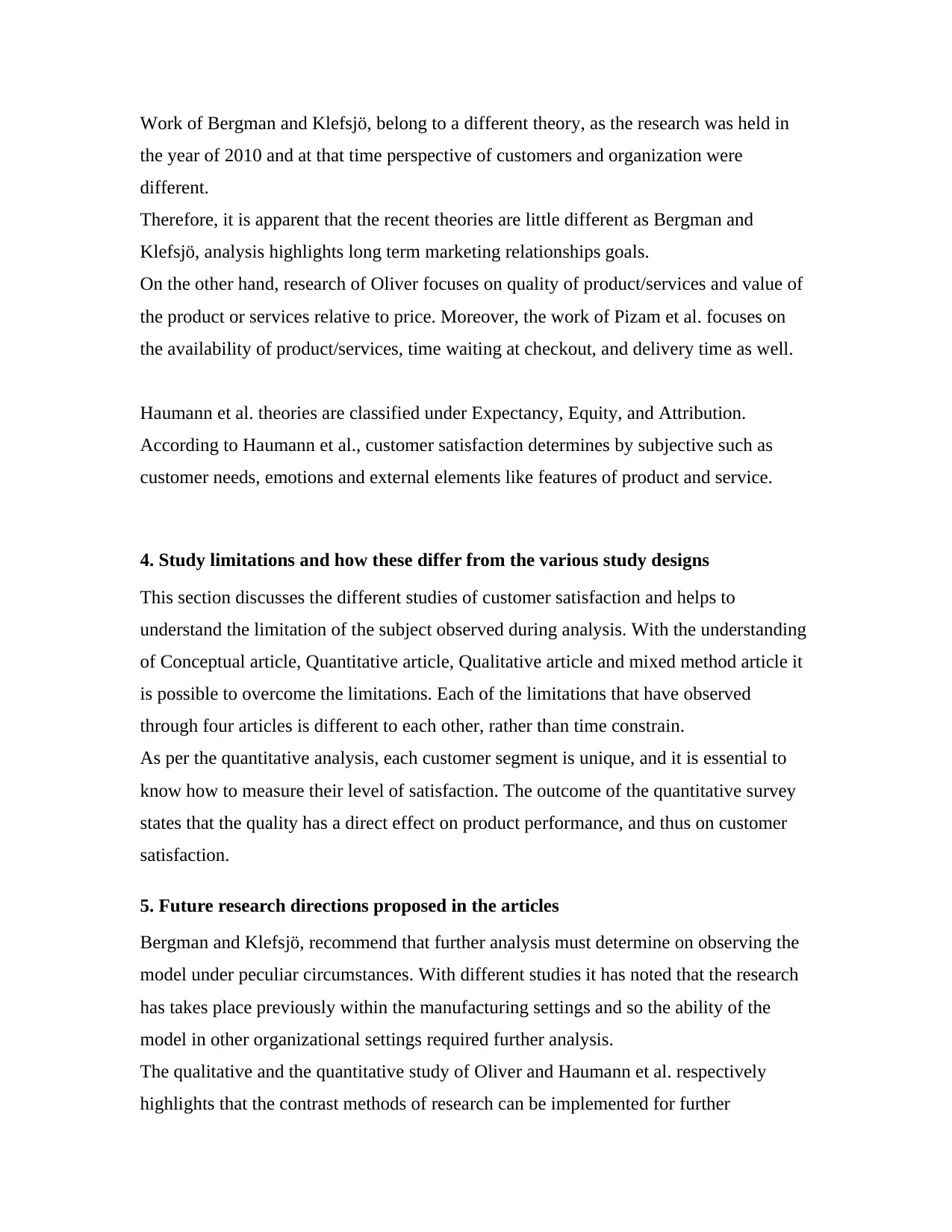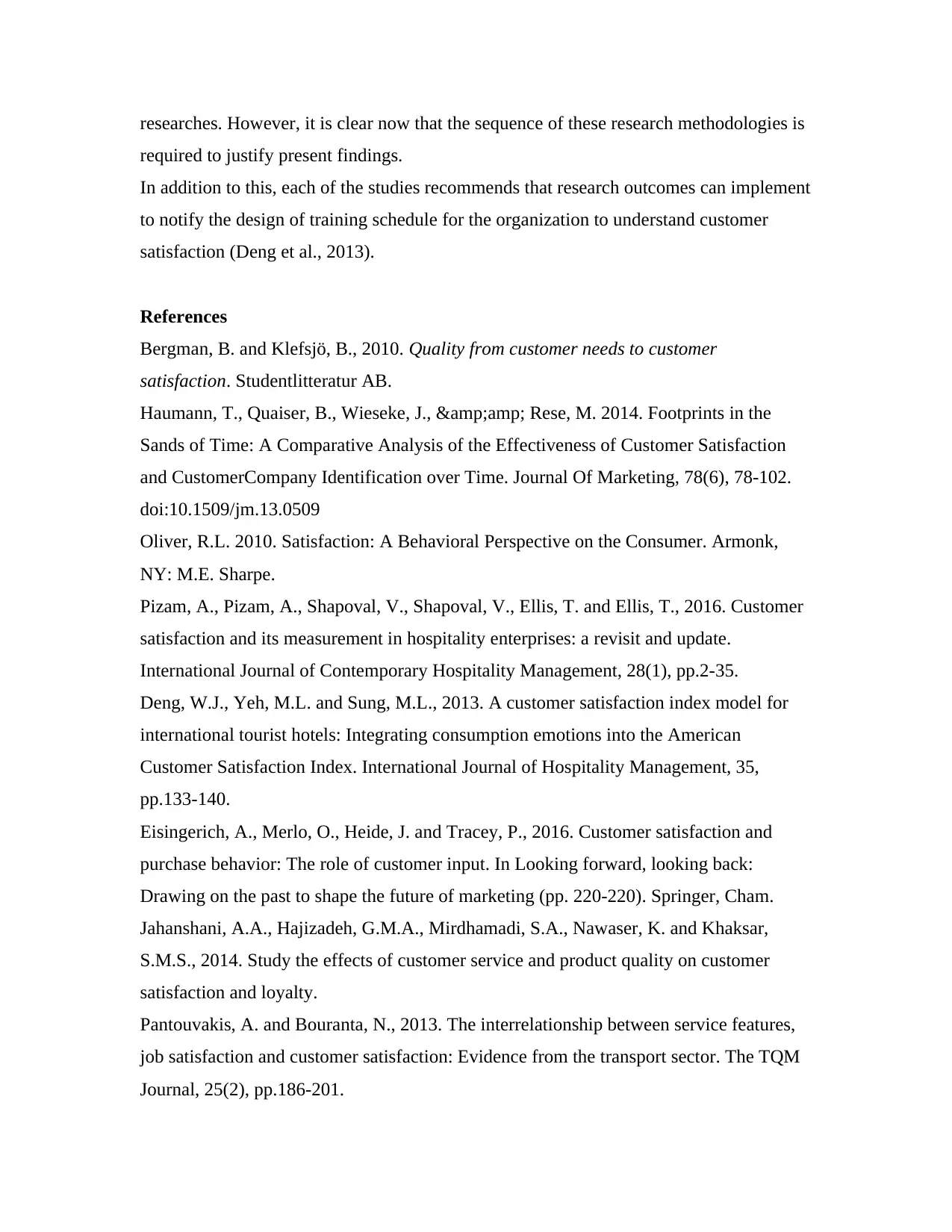University Business Research: Customer Satisfaction Abstract Analysis
VerifiedAdded on 2020/03/02
|5
|1387
|56
Report
AI Summary
This report presents a structured abstract analyzing various research studies on customer satisfaction. It begins by summarizing the evolution of customer satisfaction theory, highlighting the perspectives of Bergman and Klefsjö, emphasizing commitment and loyalty, and the contributions of Haumann et al., Oliver, and Pizam et al. The report identifies common findings across the articles, such as the significance of loyalty and commitment, while also contrasting their individual focuses, including product quality, value, and service availability. Study limitations are discussed, differentiating between conceptual, quantitative, qualitative, and mixed-method articles. The report concludes by exploring future research directions proposed in the articles, suggesting the use of contrast research methods and the importance of implementing research outcomes to design training schedules to improve customer satisfaction. The analysis provides a comprehensive overview of the key aspects of customer satisfaction and their implications for business performance and customer relationship management.

BUSINESS RESEARCH METHODOLOGY
Name of the student:
Name of the University:
Name of the student:
Name of the University:
Paraphrase This Document
Need a fresh take? Get an instant paraphrase of this document with our AI Paraphraser

Assessment 1: Structured Abstract
Structured abstract will highlight the different theoretical concept of “Customer
Satisfaction” with the help of research studies conducted by Bergman and Klefsjö,
Haumann et al., Oliver and Pizam et al.
1. A brief summary of the theory and progression in the field (i.e., how has the
theory developed since first proposed?)
According to the research conducted by Bergman and Klefsjö, in 2010, is one of the
significant perspective of customer satisfaction is “commitment and loyalty”, this helps to
build a trustworthy relationship between customer and service providers. Bergman and
Klefsjö, also emphasizes on different dimensions of customer satisfaction within the
context, relationship commitment that helps to bring loyalty, compelling commitment,
which can only form by personal communications, and trust, and also by providing
quality in product and services.
Bergman and Klefsjö, observes that Loyalty is frequently explained as actual retention,
and this is a cornerstone of customer relationship management. The author has observed
that customer satisfaction emphasizes on the attitudes of customers regarding product,
services as well as brands. As per
Bergman and Klefsjö, one can keep their customer happy by providing quality and
loyalty. The author recognizes that satisfaction of customers postulate as one of the key
indicators of business performance.
It is apparent that researching the subject of customer satisfaction in 2010 has carried out
various variables and all these models have support to build positive relations among the
providers and customers. Through these theses, it is now very much possible to
understand the customers’ expectations and to work on providing them complete
satisfaction (Jahanshani et al., 2014).
Structured abstract will highlight the different theoretical concept of “Customer
Satisfaction” with the help of research studies conducted by Bergman and Klefsjö,
Haumann et al., Oliver and Pizam et al.
1. A brief summary of the theory and progression in the field (i.e., how has the
theory developed since first proposed?)
According to the research conducted by Bergman and Klefsjö, in 2010, is one of the
significant perspective of customer satisfaction is “commitment and loyalty”, this helps to
build a trustworthy relationship between customer and service providers. Bergman and
Klefsjö, also emphasizes on different dimensions of customer satisfaction within the
context, relationship commitment that helps to bring loyalty, compelling commitment,
which can only form by personal communications, and trust, and also by providing
quality in product and services.
Bergman and Klefsjö, observes that Loyalty is frequently explained as actual retention,
and this is a cornerstone of customer relationship management. The author has observed
that customer satisfaction emphasizes on the attitudes of customers regarding product,
services as well as brands. As per
Bergman and Klefsjö, one can keep their customer happy by providing quality and
loyalty. The author recognizes that satisfaction of customers postulate as one of the key
indicators of business performance.
It is apparent that researching the subject of customer satisfaction in 2010 has carried out
various variables and all these models have support to build positive relations among the
providers and customers. Through these theses, it is now very much possible to
understand the customers’ expectations and to work on providing them complete
satisfaction (Jahanshani et al., 2014).

The variables acknowledged by Bergman and Klefsjö, within his hypothesis have been
tested with depth by the other authors. Moreover, other authors Haumann et al., Oliver
and Pizam et al. have also an emphasis on the aspects of customer satisfaction. However,
the subject of discussion is broad and based on many contextual variables, like the
product, services, industries.
2. Common findings across the four articles
According to Bergman and Klefsjö, commitment and loyalty are the significant aspects of
Customer Satisfaction, where loyalty and commitment are the critical factors in
customer’s effectiveness.
Therefore, Haumann et al., Oliver and Pizam et al., also emphasizes that loyalty and
commitment is a significant aspect of customer satisfaction in organizational outcomes.
Hausmann et al. highlights that Customer satisfaction is a method which can help the
management to understand how well the expectations of a customer associated with
different product or service offered by respective companies have been met.
As per the research of the Haumann et al., concept of Customer satisfaction is abstract.
Apart from this, authors like Oliver and Pizam et al. has also put forward some of the
theories regarding customer satisfaction that can influence the business of organization in
the market. However, customer satisfaction should be the supreme priority of every
organization to increase their business in such a competitive market (Eisingerich et al.,
2016).
3. Different findings across the four articles
In order to bring out the contrasting theories across the articles is quite difficult here, as
the studies of individual author focuses on particular and effectively unique perspective
of customer’s satisfaction which can help further in different aspects (Pantouvakis and
Bouranta, 2013).
tested with depth by the other authors. Moreover, other authors Haumann et al., Oliver
and Pizam et al. have also an emphasis on the aspects of customer satisfaction. However,
the subject of discussion is broad and based on many contextual variables, like the
product, services, industries.
2. Common findings across the four articles
According to Bergman and Klefsjö, commitment and loyalty are the significant aspects of
Customer Satisfaction, where loyalty and commitment are the critical factors in
customer’s effectiveness.
Therefore, Haumann et al., Oliver and Pizam et al., also emphasizes that loyalty and
commitment is a significant aspect of customer satisfaction in organizational outcomes.
Hausmann et al. highlights that Customer satisfaction is a method which can help the
management to understand how well the expectations of a customer associated with
different product or service offered by respective companies have been met.
As per the research of the Haumann et al., concept of Customer satisfaction is abstract.
Apart from this, authors like Oliver and Pizam et al. has also put forward some of the
theories regarding customer satisfaction that can influence the business of organization in
the market. However, customer satisfaction should be the supreme priority of every
organization to increase their business in such a competitive market (Eisingerich et al.,
2016).
3. Different findings across the four articles
In order to bring out the contrasting theories across the articles is quite difficult here, as
the studies of individual author focuses on particular and effectively unique perspective
of customer’s satisfaction which can help further in different aspects (Pantouvakis and
Bouranta, 2013).
⊘ This is a preview!⊘
Do you want full access?
Subscribe today to unlock all pages.

Trusted by 1+ million students worldwide

Work of Bergman and Klefsjö, belong to a different theory, as the research was held in
the year of 2010 and at that time perspective of customers and organization were
different.
Therefore, it is apparent that the recent theories are little different as Bergman and
Klefsjö, analysis highlights long term marketing relationships goals.
On the other hand, research of Oliver focuses on quality of product/services and value of
the product or services relative to price. Moreover, the work of Pizam et al. focuses on
the availability of product/services, time waiting at checkout, and delivery time as well.
Haumann et al. theories are classified under Expectancy, Equity, and Attribution.
According to Haumann et al., customer satisfaction determines by subjective such as
customer needs, emotions and external elements like features of product and service.
4. Study limitations and how these differ from the various study designs
This section discusses the different studies of customer satisfaction and helps to
understand the limitation of the subject observed during analysis. With the understanding
of Conceptual article, Quantitative article, Qualitative article and mixed method article it
is possible to overcome the limitations. Each of the limitations that have observed
through four articles is different to each other, rather than time constrain.
As per the quantitative analysis, each customer segment is unique, and it is essential to
know how to measure their level of satisfaction. The outcome of the quantitative survey
states that the quality has a direct effect on product performance, and thus on customer
satisfaction.
5. Future research directions proposed in the articles
Bergman and Klefsjö, recommend that further analysis must determine on observing the
model under peculiar circumstances. With different studies it has noted that the research
has takes place previously within the manufacturing settings and so the ability of the
model in other organizational settings required further analysis.
The qualitative and the quantitative study of Oliver and Haumann et al. respectively
highlights that the contrast methods of research can be implemented for further
the year of 2010 and at that time perspective of customers and organization were
different.
Therefore, it is apparent that the recent theories are little different as Bergman and
Klefsjö, analysis highlights long term marketing relationships goals.
On the other hand, research of Oliver focuses on quality of product/services and value of
the product or services relative to price. Moreover, the work of Pizam et al. focuses on
the availability of product/services, time waiting at checkout, and delivery time as well.
Haumann et al. theories are classified under Expectancy, Equity, and Attribution.
According to Haumann et al., customer satisfaction determines by subjective such as
customer needs, emotions and external elements like features of product and service.
4. Study limitations and how these differ from the various study designs
This section discusses the different studies of customer satisfaction and helps to
understand the limitation of the subject observed during analysis. With the understanding
of Conceptual article, Quantitative article, Qualitative article and mixed method article it
is possible to overcome the limitations. Each of the limitations that have observed
through four articles is different to each other, rather than time constrain.
As per the quantitative analysis, each customer segment is unique, and it is essential to
know how to measure their level of satisfaction. The outcome of the quantitative survey
states that the quality has a direct effect on product performance, and thus on customer
satisfaction.
5. Future research directions proposed in the articles
Bergman and Klefsjö, recommend that further analysis must determine on observing the
model under peculiar circumstances. With different studies it has noted that the research
has takes place previously within the manufacturing settings and so the ability of the
model in other organizational settings required further analysis.
The qualitative and the quantitative study of Oliver and Haumann et al. respectively
highlights that the contrast methods of research can be implemented for further
Paraphrase This Document
Need a fresh take? Get an instant paraphrase of this document with our AI Paraphraser

researches. However, it is clear now that the sequence of these research methodologies is
required to justify present findings.
In addition to this, each of the studies recommends that research outcomes can implement
to notify the design of training schedule for the organization to understand customer
satisfaction (Deng et al., 2013).
References
Bergman, B. and Klefsjö, B., 2010. Quality from customer needs to customer
satisfaction. Studentlitteratur AB.
Haumann, T., Quaiser, B., Wieseke, J., & Rese, M. 2014. Footprints in the
Sands of Time: A Comparative Analysis of the Effectiveness of Customer Satisfaction
and CustomerCompany Identification over Time. Journal Of Marketing, 78(6), 78-102.
doi:10.1509/jm.13.0509
Oliver, R.L. 2010. Satisfaction: A Behavioral Perspective on the Consumer. Armonk,
NY: M.E. Sharpe.
Pizam, A., Pizam, A., Shapoval, V., Shapoval, V., Ellis, T. and Ellis, T., 2016. Customer
satisfaction and its measurement in hospitality enterprises: a revisit and update.
International Journal of Contemporary Hospitality Management, 28(1), pp.2-35.
Deng, W.J., Yeh, M.L. and Sung, M.L., 2013. A customer satisfaction index model for
international tourist hotels: Integrating consumption emotions into the American
Customer Satisfaction Index. International Journal of Hospitality Management, 35,
pp.133-140.
Eisingerich, A., Merlo, O., Heide, J. and Tracey, P., 2016. Customer satisfaction and
purchase behavior: The role of customer input. In Looking forward, looking back:
Drawing on the past to shape the future of marketing (pp. 220-220). Springer, Cham.
Jahanshani, A.A., Hajizadeh, G.M.A., Mirdhamadi, S.A., Nawaser, K. and Khaksar,
S.M.S., 2014. Study the effects of customer service and product quality on customer
satisfaction and loyalty.
Pantouvakis, A. and Bouranta, N., 2013. The interrelationship between service features,
job satisfaction and customer satisfaction: Evidence from the transport sector. The TQM
Journal, 25(2), pp.186-201.
required to justify present findings.
In addition to this, each of the studies recommends that research outcomes can implement
to notify the design of training schedule for the organization to understand customer
satisfaction (Deng et al., 2013).
References
Bergman, B. and Klefsjö, B., 2010. Quality from customer needs to customer
satisfaction. Studentlitteratur AB.
Haumann, T., Quaiser, B., Wieseke, J., & Rese, M. 2014. Footprints in the
Sands of Time: A Comparative Analysis of the Effectiveness of Customer Satisfaction
and CustomerCompany Identification over Time. Journal Of Marketing, 78(6), 78-102.
doi:10.1509/jm.13.0509
Oliver, R.L. 2010. Satisfaction: A Behavioral Perspective on the Consumer. Armonk,
NY: M.E. Sharpe.
Pizam, A., Pizam, A., Shapoval, V., Shapoval, V., Ellis, T. and Ellis, T., 2016. Customer
satisfaction and its measurement in hospitality enterprises: a revisit and update.
International Journal of Contemporary Hospitality Management, 28(1), pp.2-35.
Deng, W.J., Yeh, M.L. and Sung, M.L., 2013. A customer satisfaction index model for
international tourist hotels: Integrating consumption emotions into the American
Customer Satisfaction Index. International Journal of Hospitality Management, 35,
pp.133-140.
Eisingerich, A., Merlo, O., Heide, J. and Tracey, P., 2016. Customer satisfaction and
purchase behavior: The role of customer input. In Looking forward, looking back:
Drawing on the past to shape the future of marketing (pp. 220-220). Springer, Cham.
Jahanshani, A.A., Hajizadeh, G.M.A., Mirdhamadi, S.A., Nawaser, K. and Khaksar,
S.M.S., 2014. Study the effects of customer service and product quality on customer
satisfaction and loyalty.
Pantouvakis, A. and Bouranta, N., 2013. The interrelationship between service features,
job satisfaction and customer satisfaction: Evidence from the transport sector. The TQM
Journal, 25(2), pp.186-201.
1 out of 5
Related Documents
Your All-in-One AI-Powered Toolkit for Academic Success.
+13062052269
info@desklib.com
Available 24*7 on WhatsApp / Email
![[object Object]](/_next/static/media/star-bottom.7253800d.svg)
Unlock your academic potential
Copyright © 2020–2025 A2Z Services. All Rights Reserved. Developed and managed by ZUCOL.





